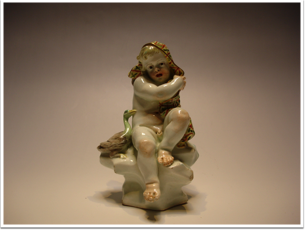1743年にナポリに軟質磁器窯カポディモンテを開いたナポリ王カルロ7世(CarloⅦ)は、1759年にスペイン王フェルナンド6世が急逝した為、急遽スペイン王カルロス3世(CarlosⅢ)として即位した。
その際、1760年、カポディモンテ窯の設備、原料、職人を、何艘ものカラベル船でそっくりマドリッドの郊外のブエン・レティーロに移し、同じ軟質磁器窯を開いた。
その為に、この窯の初期の作品はカポディモンテ窯と酷似しており、鑑別が難しいものも少なく無い(パレットで判断されることも多い)。度重なる経営難の中、1803年にセーヴルより硬質磁器の製法を購入し、硬質磁器窯に転向する。
しかし1808年よりのナポレオン戦争でフランス軍がマドリッドに侵攻し、この窯は略奪され、1812年に閉窯する。
この窯は、大きく4つの時期に分けられる。
第1期 1760ー1770/ Etapa de Giussepe Jose Gricci
第2期 1770ー1783/ Etapa de Carlos Scheppers
第3期 1783ー1803/ Etapa de Carlos Scheppers and Felipe Gricci
第4期 1803ー1808/ Etapa de Bartolome Sureda
1/ Italian period. Giuseppe Jose Gricci was the director. Modelers were Basilio,
Cayetano,Bautista brothers,Scheppers brothers, and Salvador Nofri.
The taste was Baroque and the porcelain room of the palace Aranjuez in Madrid
is typical example, which is decorated with many Chinese figures and imitated
the palace Portici in Naples. The vase was applied with the brass from 1764.
2/ After the death of G.Jose Gricci, the factory suffered from the economic crisis.
Scheppers tried to improve the paste to mix the glass and the soil of Galapagar.
But it is difficult to distinguish the first from the second period by the paste or
the model.
3/ Scheppers died in 1783. Felipe Gricci get the director until Sureda ‘s entrance.
The style was changed to imitate the Wedgewood porcelain in England though
the Italian influence continued.The example is El Escorial, the House of Prince.
4/ To resolve the severe economic crisis in 1788, Sureda was sent to Sevres to get
the secret of the hard paste.In 1804 the paste has changed to hard paste and
the French infuluence get predominant.
Referencia
Catálogo de Porcelana y Cerámica Española
del Patrimonio Nacional enLosPalacios Reales. Vol. I por M. L. Sanchez
Le service de la Princesse des Asturies
Ou l'histoire d'un cadeau royal pour la cour de Madrid par Dorothée Guillemé-Brulon

Buen Retiro(1760-1812) Spain

